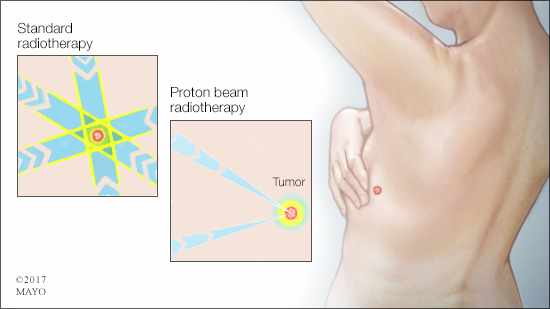-
Cancer
Mayo Clinic Q and A: Proton beam therapy may be recommended for some types of cancer
 DEAR MAYO CLINIC: My mother recently was diagnosed with breast cancer, and her doctor told her regular radiation wasn’t as safe as proton beam therapy for her situation. Why would this be the case? I know lots of women who have had radiation for breast cancer treatment.
DEAR MAYO CLINIC: My mother recently was diagnosed with breast cancer, and her doctor told her regular radiation wasn’t as safe as proton beam therapy for her situation. Why would this be the case? I know lots of women who have had radiation for breast cancer treatment.
ANSWER: It’s true that standard radiation therapy often is used to treat breast cancer. In some cases, however, proton beam therapy can be a better choice, particularly for women who have cancer that affects their left breast. That’s because the way proton beam therapy is delivered can prevent the dose of radiation from reaching the heart, and that lowers the risk of potential long-term side effects from treatment.
Protons are subatomic particles that combine with neutrons to form the nucleus of an atom surrounded by orbiting electrons. Radiation is energy released from atoms as an electromagnetic wave, such as X-rays, gamma rays or electrons, or as tiny particles, such as protons. For more than 120 years, radiation has been used to destroy cancer cells.
Today’s standard radiation therapy uses high-energy X-rays that travel through the body. Proton beam therapy is different. This treatment directs protons into a tumor, where their energy is released. Radiation oncologists can control the depth of penetration of the protons and where they release their energy by adjusting the energy of the protons. That allows higher doses of radiation to be more safely delivered to tumors with less risk to surrounding tissues and organs.
Proton beam therapy isn’t necessary or used for all types of cancer. But it is beneficial in the treatment of certain kinds of tumors, including brain and breast cancer, along with many pediatric cancers. The percentage of cancer patients who need proton beam therapy, rather than standard radiation therapy, is small — only about 2 to 3 percent. For those who require this treatment, the advantages can be significant.
There are several groups in particular who usually benefit most from proton beam therapy. First, proton beam therapy is well-suited for children. Radiation therapy can cause cancers, heart disease and other chronic health problems decades later in children and young adults who are cured of their cancer by radiation therapy. Proton beam therapy lowers the risk of chronic health problems, because the child’s body is exposed to a lower dose of radiation, compared to standard radiation therapy.
People with tumors close to organs that are sensitive to radiation injury ─ even with low doses of radiation ─ are the second group of ideal candidates for proton beam therapy. Some women with left-sided breast cancers fall into this category. Standard radiation therapy delivered to the left side of the chest, where the heart is located, may lead to heart problems, such as heart attacks and heart failure, among others. By using proton beam therapy, the heart doesn’t receive a dose of radiation, and that reduces the risk for heart complications later in life.
For the same reason, proton beam therapy may be recommended for treating tumors located deep within the body, when concern about damage to healthy organs and tissue may otherwise require that the standard radiation treatment dose be decreased. For example, proton beam therapy often is considered a good option for brain, head and neck, esophageal, liver, and lung cancers in adults.
If your mother has questions or concerns about proton beam therapy, encourage her to talk with her radiation oncologist. He or she can explain proton beam therapy in more detail, review your mother’s treatment plan with her, and walk her through the risks and benefits for her individual situation. — Dr. Nadia Laack, Radiation Oncology, Mayo Clinic, Rochester, Minnesota







